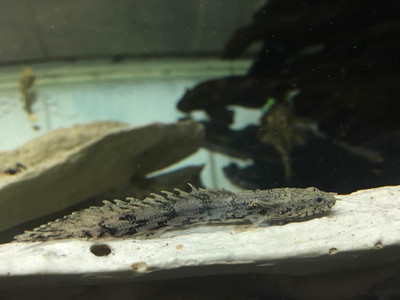Endlicheri Bichir
Posted by Max Gandara on on 4th May 2025
Endlicheri Bichir (Polypterus endlicheri endlicheri): The Prehistoric Predator for the Modern Aquarium
For aquarists fascinated by ancient-looking fish with serious personality, the Endlicheri Bichir (Polypterus endlicheri endlicheri) is an unbeatable choice. Often described as a “living fossil,” this large, bottom-dwelling predator brings Jurassic flair to freshwater tanks. With its armored body, toothy grin, and powerful swimming style, the Endlicheri Bichir is both intimidating and oddly endearing.
Whether you're building a monster fish setup or curating a West African biotope, this species is a must-see — and for the right aquarist, a must-keep.
Origins and Natural Habitat
Native to slow-moving, swampy waters and floodplains of central and western Africa, including the Nile, Chad, and Niger River basins, the Endlicheri Bichir thrives in warm, muddy environments rich in vegetation and hiding places. These rivers are subject to seasonal flooding, which has influenced the bichir’s unique physiology — including its ability to breathe air and survive in low-oxygen water.
Appearance
The Endlicheri Bichir looks like it swam straight out of the age of dinosaurs. With a long, eel-like body and a row of prehistoric dorsal finlets, it combines form and function in one fearsome-looking package.
Key Features:
-
Size: Up to 30 inches (76 cm) in the wild; typically 18–24 inches (45–60 cm) in aquariums
-
Body: Thick, muscular, and armored with ganoid scales
-
Coloration: Cream or yellowish base with irregular dark blotches and bands (patterns vary by individual)
-
Head: Wide, flat, with small eyes and a slightly upturned mouth packed with tiny sharp teeth
-
Fins: 7–9 dorsal finlets, broad pectoral fins for "walking" across the substrate
Tank Setup and Requirements
This is not a fish for small or lightly stocked tanks. The Endlicheri Bichir requires space, stability, and secure tank design to thrive.
Ideal Tank Conditions:
-
Tank Size: Minimum 100 gallons (larger for adults or groups)
-
Temperature: 75°F to 82°F (24°C to 28°C)
-
pH: 6.5 to 7.8
-
Substrate: Soft sand or smooth gravel
-
Décor: Driftwood, caves, rocks — plenty of hiding places and open floor space
-
Lighting: Low to moderate — they prefer dim environments
-
Filtration: Strong and efficient — bichirs are messy eaters
-
Lid: Airtight and heavy — bichirs are escape artists and breathe atmospheric air
Bichirs are benthic (bottom-dwelling) and use their modified swim bladder to breathe air, so access to the surface is crucial.
Behavior and Temperament
Despite their fearsome looks, Endlicheri Bichirs are generally peaceful — but highly opportunistic. If it fits in their mouth, it will eventually disappear.
Temperament:
-
Solitary, calm, slow-moving
-
Nocturnal or crepuscular (most active at dawn and dusk)
-
Peaceful toward similar-sized tankmates, but predatory toward smaller fish
-
Intelligent and responsive — many recognize their keepers
Tankmates:
-
Compatible: Other bichirs, large catfish (e.g., Synodontis), arowanas, datnoids, Oscars, silver dollars (if too big to swallow)
-
Avoid: Small tetras, guppies, shrimp, snails, or anything under 3 inches — they will become dinner
Diet and Feeding
Bichirs are carnivorous and prefer meaty, protein-rich foods. They are slow, deliberate feeders that often hunt by scent.
Best Foods:
-
Frozen or live: bloodworms, blackworms, shrimp, krill, chopped fish fillet
-
Pellets: sinking carnivore or predator pellets (Hikari, NorthFin, etc.)
-
Occasional treats: earthworms, small feeder fish (only quarantined and safe)
Feed 2–3 times per week in small portions. Juveniles eat more frequently.
Growth and Lifespan
-
Growth rate: Fast in early stages; slows with age
-
Lifespan: 10–15 years, potentially over 20 with excellent care
-
Maturity: Sexual dimorphism is subtle; males have broader anal fins
They need consistent care and excellent water quality to avoid infections or digestive issues.
Breeding
Breeding Endlicheri Bichirs in home aquariums is rare and difficult. They require:
-
Large breeding tanks
-
Seasonal changes in water chemistry
-
Floating vegetation for egg scattering
They are egg scatterers with no parental care. Most specimens in the hobby are wild-caught or farm-raised in Asia.
Final Thoughts
The Endlicheri Bichir is a living relic — part fish, part fossil, and fully fascinating. Though not suitable for community or nano tanks, it shines in large, predator-themed or species-focused setups. Its combination of size, looks, and ancient charm make it a centerpiece species for any serious freshwater aquarist.

